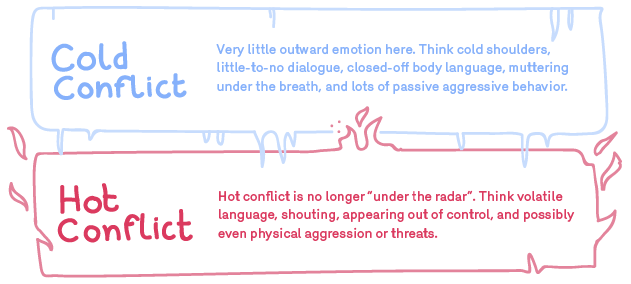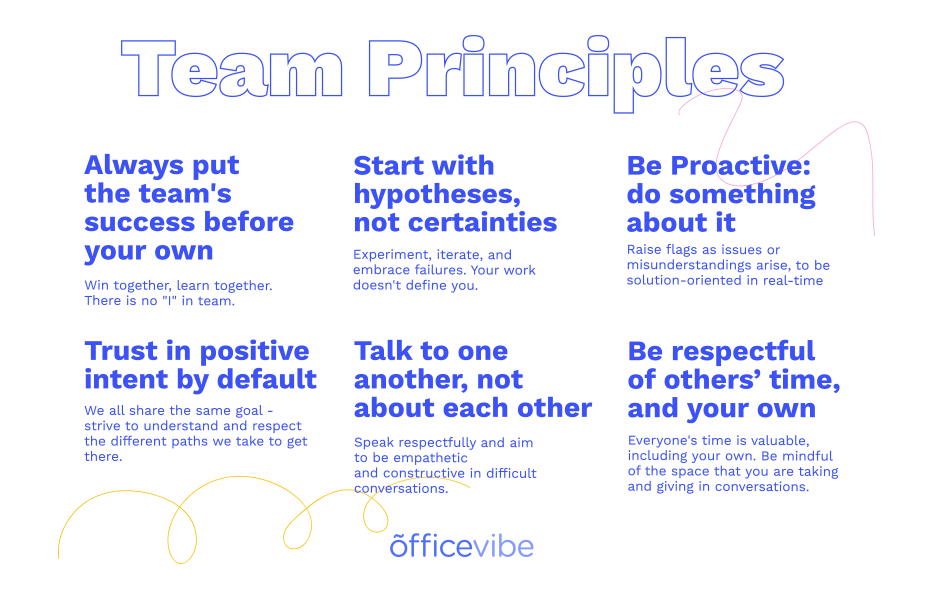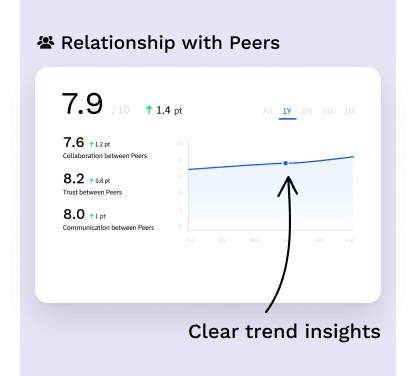Employee conflict is an inevitable and natural part of working with collaborative teams. Yet, in a remote context, we tend to shy away from conflict, given how teams are physically separated and may turn to a “just get on with it” mindset. It’s important for managers to remember: you’re not only managing your team’s workflow, you’re also making sure team dynamics have solid foundational elements like trust, support, and open communication.
According to Officevibe’s user data:
21% of employees don’t feel that communication among their peers is honest and transparent.
Let’s examine how managers can spot warning signs of workplace conflict with their remote teams and how to diffuse these instances for a positive work environment.
Assess your organization’s employee experience in minutes

What's in this article
What are common causes of employee conflict?
What causes conflict on teams? It can be a number of things. Many of them you can control as a manager, so long as you intentionally take the time to check in on each one.
- Unclear roles and expectations on the team: Does each employee understand what is expected of them and their peers? Giving visibility on how each employee is expected to develop and contribute to the team will foster a sense of clarity and harmony, rather than stepping on each other’s toes, repeating work, and working in silos.
- Lack of trust and solid relationships: Where trust is lacking conflict is inevitable. Do employees know each other well enough to build trust? Carving out the time for the team to work on personal relationships, inclusion and team dynamics is essential in avoiding conflict. Don’t take for granted that this takes work and does not always happen naturally.
- Unclear collaboration guidelines and work processes: Every team needs clear processes and a streamlined understanding of “how we work”. Whether this is regarding communication tools, working hours, project workflows, this alignment is key to keeping people moving in the same direction conflict-free. These guidelines are especially important in a remote context.
How can you notice signs of employee conflict?
Here’s how managers can pinpoint the tell-tale signs of workplace conflict. This may be more difficult to pinpoint in a remote context, paying special attention on virtual calls is helpful.
- During meetings, notice how your team reacts to one another and involves each other. Are they truly collaborating?
- Notice if employees feel as though they can’t speak up or express their opinions and perspective. Where there’s conflict there’s a need for a safe space to be upfront about grievances.
- Observe employees who frequently disagree and get defensive. It’s one thing for employees to be enthusiastic, it’s another when this behaviour results in arguments, interruptions, disagreements and miscommunication.
- Is your team delivering and being productive? When conflict arises it becomes more difficult to get work done together.
6 management strategies to handle employee conflict
Don’t wait or sweep it under the rug:
Addressing conflict as it occurs encourages a solution-oriented mindset further diffusing the situation and prevents it from escalating.
Speak about behavior not personality to avoid escalating the conflict.
Discuss the facts and avoid drawing attention towards behavioural patterns. If these need to be discussed, book separate 1-on-1’s with each employee.
Neutralize discussions
Meditation goes a long way. Use effective communication to maintain a solution-oriented mindset. Use language that prevents blame, and allow each employee to speak about their situation.
Give time to each team member to express themselves
Adequately timing discussions give employees the space to express how they feel and equalizes the playing field. This prevents conflict-avoidance and interruptions.
Sum up what was discussed
Recap and solidify actionable next steps agreed upon by each employee. Once everyone agrees to possible solutions, ask each employee to finish this sentence: I commit to ____ and will show this in my behaviour by _____ this change will begin _____.
Follow up
It’s your responsibility as a leader to make sure that employees are adjusting their behaviour. Book a follow-up meeting to discuss how the conflict has evolved and remain inquisitive during regularly scheduled 1-on-1s.
Types of employee conflict you might encounter on your team
Because your team comes with different personality types, you’ll see different types of conflict. Some people avoid conflict and confrontation, while other employees might revel in a good heated discussion, or even seek it out.
Conflicts may be multidimensional. Consider if the conflict in question is manifesting as:
- Employee to employee: grievances arising within the team.
- Manager to employees: your relationships with each team member.
- Team to team: employees cross collaborating with other teams may disagree or miscommunicate based on differing team principles and value systems.
The Harvard Business Review categorizes conflict in the workplace under two banners: Hot conflict and cold conflict.
Knowing the difference helps when it comes to conflict management:

How to approach a cold conflict
- The focus in a cold conflict is on starting a constructive dialogue with both employees. The goal is to get them talking as you lead the conversation. Note that cold conflicts involve a lot of repressed emotions. Be prepared for the situation to warm and emotions surface.
How to approach a hot conflict
- Bringing two people together who are embroiled in a heated conflict can be dicey. Allow team members to cool off, then, set clear and concise ground rules for each participant before entering a discussion.
How to prevent employee conflict going forward
Managing conflict as it comes up will always be part of your role, and to keep conflict at bay as much as possible, you can do some solid preventive work. Especially in a remote work environment when connections are harder to build between screens.
Managers and teams need to prioritize their emotional intelligence and ground work to reduce the chances of potential conflict. Here’s how:
1. Build a set of team principles:
Set up a group brainstorming session to define acceptable behaviours and determine the team’s values to live by. Team principles or guiding norms become a sort of contract between employees based on mutual respect and promotes empathy and open communication. The more you influence your team to identify with a culture of respect, the easier it will be for them to productively iron out their wrinkles.
Here’s an example of our team principles, and the story of the steps we took to build them:

2. Collect data to understand your team's dynamics:
Officevibe helps managers collect tangible insights on something otherwise really hard to measure: relationships between peers.
Our employee survey questions give managers all the data they need to learn when things are going well between peers, and when they need to intervene. Using this data, managers can host team meetings for productive conversations. As a result, deep-diving in to anonymous feedback related to a particular metric to fix concerns on their team.
Examples of relationship-based survey questions for managers:
Are communications between my peers honest and transparent? Do you and your peers collaborate well together? On a scale of 0-10 how much do you trust your peers? My peers welcome opinions different from their own. On a scale from 0-10 how satisfied are you with the frequency at which you communicate with your peers?
Start measuring peer to peer relationships, and other metrics that help managers make their teams great.

Officevibe helps you keep track of clear trend insights within your team
As a leader, ironing out conflict within your team is part of your responsibility. Connecting with your team frequently about how they’re feeling and how you can better support them is the first step. If employee conflicts are particularly difficult, don’t be afraid to host a remote feedback workshop, and leverage Officevibe’s pulse survey tool and 1-on-1 meeting tool to get everyone’s cards on the table.
Equip HR and managers with tools to engage, recognize, and drive performance.




